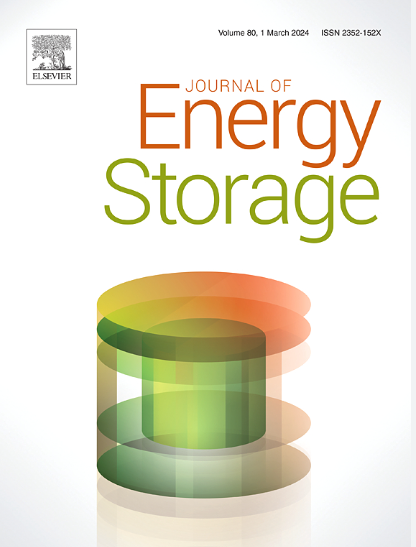State-of-health estimation of lithium-ion batteries using a kernel support vector machine tuned by a new nonlinear gray wolf algorithm
IF 8.9
2区 工程技术
Q1 ENERGY & FUELS
引用次数: 0
Abstract
The computer-aided estimation of battery state of health (SOH) has been regarded as an active field of energy management because of the high demand for electric vehicles and consumer electronics. In this study, a new data-driven model is proposed for the capacity prediction and online monitoring of lithium-ion batteries, which is formulated based on a kernel support vector machine (KSVM) and a nonlinear Gray Wolf Optimization (NGWO) to capture the health information in electrochemical impedance spectroscopy (EIS) data. The amplitudes of EIS in the frequency range from 0.02 Hz to 20,000 Hz are taken as the input variables of KSVM model to predict the capacity at different cycles of battery charge-discharging. Moreover, GWO is improved through the proposed new inverse S-shaped exponential compound function convergence factor and position ratio-based dynamic weighting scheme to enhance its accuracy in optimizing KSVM parameters. The capacity prediction tasks of single battery (Case 1), different batteries at different temperatures (Case 2) and limited cyclic data (Case 3) are discussed in detail. Experimental results show that compared with other estimation methods, the NGWO-KSVM exhibit the lowest root mean square error (0.073 and 0.075 in Case 1, 0.434 and 0.263 in Case 2), the smallest mean absolute percentage error (0.052 and 0.055 in Case 1, 0.286 and 0.178 in Case 2), and the highest determination coefficient (0.936 and 0.956 in Case 1, and 0.981 and 0.993 in Case 2) for two different batteries in relatively short time. Also the NGWO-KSVM can more effectively utilize a fewer cycles of EIS data to improve capacity estimation performance in Case 3. It provides superior solution for the problem of low accuracy and poor robustness in battery capacity prediction, and has the potential for actual implementation in battery routine monitoring.
使用经新型非线性灰狼算法调整的核支持向量机估算锂离子电池的健康状况
由于电动汽车和消费电子产品的高需求,电池健康状况(SOH)的计算机辅助估算已被视为能源管理的一个活跃领域。本研究为锂离子电池的容量预测和在线监测提出了一种新的数据驱动模型,该模型基于核支持向量机(KSVM)和非线性灰狼优化(NGWO)来捕捉电化学阻抗光谱(EIS)数据中的健康信息。将频率范围在 0.02 Hz 至 20,000 Hz 之间的 EIS 振幅作为 KSVM 模型的输入变量,以预测电池在不同充放电周期下的容量。此外,通过提出新的反 S 型指数复合函数收敛因子和基于位置比的动态加权方案来改进 GWO,从而提高其优化 KSVM 参数的精度。详细讨论了单个电池(情况 1)、不同温度下的不同电池(情况 2)和有限循环数据(情况 3)的容量预测任务。实验结果表明,与其他估算方法相比,NGWO-KSVM 的均方根误差最小(情况 1 中为 0.073 和 0.075,情况 2 中为 0.434 和 0.263),平均绝对百分比误差最小(情况 3 中为 0.052 和 0.055),平均绝对百分比误差最小(情况 4 中为 0.434 和 0.263)。052 和 0.055,0.286 和 0.178),确定系数最高(0.936 和 0.956,0.981 和 0.993)。此外,在案例 3 中,NGWO-KSVM 能更有效地利用较少的 EIS 循环数据来提高容量估计性能。NGWO-KSVM 为解决电池容量预测精度低、鲁棒性差的问题提供了优越的解决方案,有望在电池日常监测中实际应用。
本文章由计算机程序翻译,如有差异,请以英文原文为准。
求助全文
约1分钟内获得全文
求助全文
来源期刊

Journal of energy storage
Energy-Renewable Energy, Sustainability and the Environment
CiteScore
11.80
自引率
24.50%
发文量
2262
审稿时长
69 days
期刊介绍:
Journal of energy storage focusses on all aspects of energy storage, in particular systems integration, electric grid integration, modelling and analysis, novel energy storage technologies, sizing and management strategies, business models for operation of storage systems and energy storage developments worldwide.
 求助内容:
求助内容: 应助结果提醒方式:
应助结果提醒方式:


